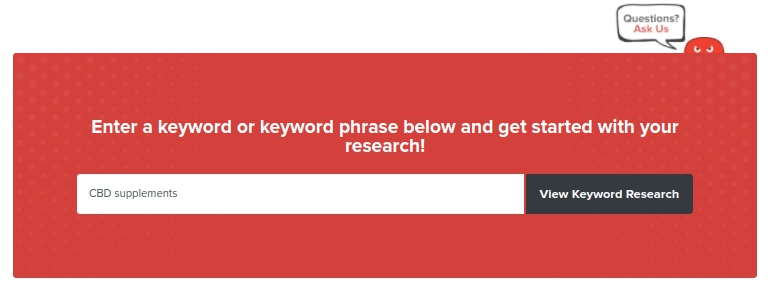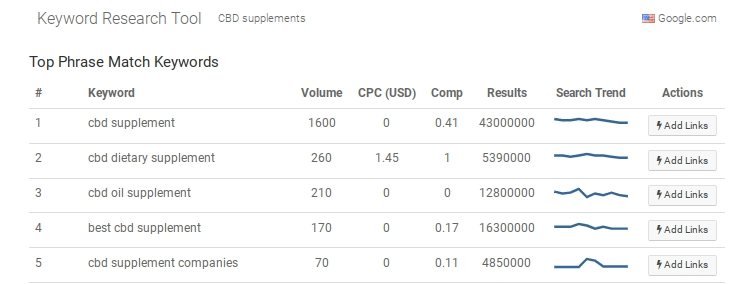Talk Strategy With An Expert
Find out how SEO can work for you. Get expert advice on the right strategy for your business!
The HOTH Google Keyword Planner Tool powered by SEMrush, helps find high-volume terms and phrases that relate to your primary keyword.
Enter a keyword or keyword phrase below and get started with your keyword research!
Get an analysis into your SEO, competitors, industry, and a roadmap to move forward with. Schedule a time to receive your report.
Finding the right keywords for your website can take your online business to the next level. Google uses keywords to rank websites based on how relevant they are to specific searches. The more keywords you rank for, the higher your pages or content will appear on the Search Engine Results Page (SERP).
With so many keywords out there, you need to do research. But, how are you supposed to do sophisticated keyword research if you’re a small or medium-sized business dipping its toes in SEO?
Our FREE Google Keyword Planner Tool is the answer!
All it takes to get started is to enter a keyword related to your online business. From that point, our tool will provide you with a comprehensive list of similar keywords to use.
Each keyword comes with valuable data:
Check out below what keyword research would look like for an online business selling “CBD supplements.”

Here is an example of the results that this business would receive.

Our tool provides 100 of the top keywords for that search term. The results can also be downloaded as a .pdf or exported as a .csv for later reference.
By clicking on “Add Links” on the left side you’re connected to HOTH Link Outreach, our highly effective link building and blogger outreach service. It’s an easy way to get more backlinks to your site.
The FREE Google Keyword Planner Tool can be accessed on this page and through your free HOTH account.
Of all the free tools we offer, the Google Keyword Planner Tool is one of the easiest to use. All you have to do is type in the relevant keyword or phrase to get the ball rolling.
The challenge comes in deciding what keywords to use and how to incorporate them into your content or web pages. More on that below!
Right now, we want to ensure you’re clear on how this tool works. Check out our video walkthrough below.
Simply book a phone call with us and we can help you out!
Here’s the moment you’ve probably been waiting for. Once you generate a list of potential keywords using our tool, how to decide which ones to choose? There are multiple characteristics that make an effective keyword.
Start off by examining the generated list and noting which keywords are near the top. These are keywords with higher search volume. It’s important to know if people are actually searching for a term before you start using it. These are the keywords with more traction.
But, the analysis doesn’t end there.
Competition is an important factor, especially for small to medium-sized businesses. You need to know how much competition there is with each keyword and be realistic about what you will really be able to rank for. It’s possible to rank on page one for some keywords, but others may be too competitive.
Even though you aren’t buying Google Ads, it’s a good idea to check a keyword’s CPC. This will indicate whether a keyword is valuable enough to incorporate into your strategy. You want keywords that will result in searches or sales, and CPC is a good indication of this.
And, finally, only choose keywords that are relevant for your business. Let’s use the CBD search above as an example.
If the company specializes in CBD for pets, then using the keyword “bodybuilding supplements CBD” wouldn’t be relevant.
There are multiple types of keywords. In this section, we’ll discuss broad match keywords, phrase match keywords, exact match keywords, and negative keywords.
Broad match keywords are designed to reach the largest possible audience. The goal of using broad match keywords is to increase your web traffic.
Some examples of these keywords include “men’s shoes” or “women’s hats.”
You might think that a broad match would be the best to use because it reaches more people. But, the problem is your visitors aren’t qualified traffic.
Someone searching for “men’s shoes” may need something to wear with a tuxedo and your company specializes in running shoes.
Phrase match keywords are more specific. They are the middle ground between broad match and exact match, offering you some additional flexibility.
Using the example above, you could add “beach day” to the keyword “women’s hats.” This helps refine the search so the right people see your site.
The exact match keyword is the opposite of a broad match. A Google user has to type the keyword exactly as it appears to find your page. They better connect your shoppers to your products, but they result in lower traffic.
You’ll need to diversify your keyword list to ensure that you include all three types.
Some websites forget about adding negative keywords but they are very important. Negative keywords are the terms you don’t want to be associated with your site.
For example, if you only sell “women’s hats for the beach,” you’ll want to include “athletic hats” on your negative keyword list. This ensures that a search for athletic hats won’t lead to your page.
Keywords are important because they are the foundation of SEO. Everything you’re trying to do to your website is based on the keywords you choose.
Google will scan your keywords to determine what your content is about and deliver it to the right people who are making a search.
Keywords are added to your web pages and serve as the basis for blog posts. They are also a glimpse into what your potential customers are searching for online.
When your keywords are perfectly optimized for your audience, your website will get more qualified traffic. This means visitors will be more likely to purchase a product, sign up for membership, or schedule a consultation.
Start off by optimizing your on-page SEO. This has to do with how you include keywords on individual web pages. Here are some tips:
Content is important for ranking. You should consistently post new content that includes the keywords you want to rank for. Focus on making the content high-quality and useful for the reader.
Only rank for one primary keyword per page. Going for too many primary keywords could actually harm your SEO.
We mentioned above how backlinks also improve your SEO ranking. That’s why you can click “Add Links” to order a guest post on another site that links back to you.
Use this tool if you’re looking to kickstart or revamp an SEO strategy for your business. Our Google Keyword Planner Tool is free, quick, and easy to use. Within a few minutes, you can generate a working list of high-performing keywords.
Once these keywords are added to your site, start tracking your web traffic and conversions. Pay attention to whether they increase or decrease. Feel free to switch up or add new keywords as needed.
Ultimately, SEO is a work in progress and you’ll need to adjust it regularly.
Need help with your SEO? Simply book a call with our team to get started.
Find keywords with data provided by SEMRush the market’s leading SEO tool. For free!
Use our tool to see:
Then when you’ve found the best keywords for your website, you can export them to CSV or download the list as a PDF.
It’s easy to use our tool:
To find long tail keywords with our tool, scan the list for longer terms.
You can also try inputting a 2-3 word keyword to see what long-tail queries are generated.
If you’ve ever used Google Adwords Keyword Planner before using The HOTH’s version, then you may already know that there’s a lot you can do with the data:
With so many different applications, using our free keyword tool or a similar one is a necessary step for doing SEO.
Next step: Scroll up and enter your first keyword to start doing some research!